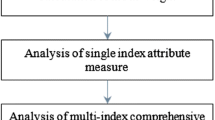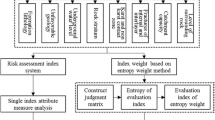Abstract
Tunnel water inrush is one of the common geological disasters in the underground engineering construction. In order to effectively evaluate and control the occurrence of water inrush, the risk assessment model of tunnel water inrush was proposed based on improved attribute mathematical theory. The trigonometric functions were adopted to optimize the attribute mathematical theory, avoiding the influence of mutation points and linear variation zones in traditional linear measurement functions on the accuracy of the model. Based on comprehensive analysis of various factors, five parameters were selected as the evaluation indicators for the model, including tunnel head pressure, permeability coefficient of surrounding rock, crushing degree of surrounding rock, relative angle of joint plane and tunnel section size, under the principle of dimension rationality, independence, directness and quantification. The indicator classifications were determined. The links among measured data were analyzed in detail, and the objective weight of each indicator was determined by using similar weight method. Thereby the tunnel water inrush risk assessment model is established and applied in four target segments of two different tunnels in engineering. The evaluation results and the actual excavation data agree well, which indicates that the model is of high credibility and feasibility.
摘要
隧道突涌水是地下工程建设中常见的地质灾害之一。 为了评估并控制突涌水的发生, 建立基于改进属性数学理论的隧道突涌水评估模型。 利用三角函数曲线对属性数学理论进行优化, 避免传统的线性预测函数的突变点以及线性变化区域对模型精度的影响。 基于对多种因素的综合分析, 选取 5 个参数作为模型评估指标, 即隧道水头压力、 围岩渗透系数、 围岩破碎程度、 节理面的相对角度以及隧道断面面积, 同时, 满足评估指标集的维度合理性、 独立性、 直接性以及可量化的原则。 详细分析了测量数据之间的关联, 并利用相似权重法确定了每项指标的目标权重, 进而建立了隧道突涌水风险评估模型。 将该方法运用到 2 条不同隧道的 4 个标段, 评价结果与实际开挖情况对比表明, 二者吻合良好, 说明模型具有较高的精度。
Similar content being viewed by others
References
LI C P, LI J J, LI Z X, HOU D Y. Establishment of spatiotemporal dynamic model for water inrush spreading processes in underground mining operations [J]. Safety Science, 2013, 55: 45–52.
SHEN X M, LIU P L, WANG J F. Evaluation of Water-inrush risks of karst tunnel with analytic hierarchy process [J]. Journal of Railway Engineering Society, 2010, 12: 56–63. (in Chinese)
DU Y C, HAN X R, LI Z L. Professional evaluating system for karst tunnel gushing based on AHP and its application [J]. Carsologica Sinica, 2009, 3: 281–287. (in Chinese)
YANG T H, TANG C A, TAN Z H, ZHU W C. State of the art of inrush models in rock mass failure and developing trend for prediction and forecast of groundwater inrush [J]. Chinese Journal of Rock Mechanics and Engineering, 2007, 2: 268–277. (in Chinese)
MIAO C L, SUN L Y, YANG L. Evaluation method for coalmining-based cities ecosystem based on attribute mathematical model with Huainan City as an example [J]. Ecological Indicators, 2015, 48: 17–21.
XU J S, LI Y X, YANG X L. Stability charts and reinforcement with piles in 3D nonhomogeneous and anisotropic soil slope [J]. Geomechanics and Engineering, 2018, 14(1): 71–81.
XU J S, PAN Q J, YANG X L, LI WT. Stability charts for rock slopes subjected to water drawdown based on the modified nonlinear Hoek-Brown failure criterion [J]. International Journal of Geomechanics, 2018, 18(1). DOI: 10.1061/(ASCE)GM.1943-5622.0001039.
YANG Z H, ZHANG R, XU J S, YANG X L. Engery analysis of rock plug thickness in karst tunnels based on non-associated flow rule and nonlinear failure criterion [J]. Journal of Central South University, 2017, 24(12): 2940–2950.
TUNG F, LITTLE J. Improving scene attribute recognition using web-scale object detectors [J]. Computer Vision and Image Understanding, 2015, 138: 86–91.
YEH Y C, SCHMEISER B W. VAMP1RE: A single criterion for rating and ranking confidence-interval procedures [J]. IIE Transactions (Institute of Industrial Engineers), 2015, 47(11): 1203–1216.
LI Z L, WANG X H, XIE L Z. Testing and applied research on grouting materials on karst tunnel water inrush [J]. Electronic Journal of Geotechnical Engineering, 2012, 17U: 2933–2942.
YANG X L, YAO C. Stability of tunnel roof in nonhomogeneous soils [J]. International Journal of Geomechanics, 2018, 18: 06018002. DOI: 10.1061/(ASCE)GM.1943-5622.0001104.
YANG X L. Lower bound analytical solution for bearing capacity factor using modified Hoek–Brown failure criterion [J]. Canadian Geotechnical Journal, 2018, 55. DOI: https://doi.org/10.1139/cgj-2016-0694.
PENG J, LI X Y. Water-inrush mechanism during construction and determination of safety distance from the water source in a karst tunnel [J]. Electronic Journal of Geotechnical Engineering, 2015, 20(8): 2345–2354.
ZHANG M Q, HUANG H J, MIAO D H, TIAN S M. Study on and determination of water pressure of the karst tunnel [J]. Journal of Railway Engineering Society, 2008, 5: 53–58. (in Chinese)
RONG G, HOU D, LIU G, PENG J. Research of permeability distribution with burial depth in the fractured rock mass in valley slope [J]. International Journal of Earth Sciences and Engineering, 2013, 6(3): 442–446.
LU X B, ZHENG W, LIU Q J, ZHAN X H. A Method for Determining the Permeability Coefficient of Fractural Rock Based on the Percolation Model [J]. China Earthquake Engineering Journal, 2011(S1): 43–47.(in Chinese)
YANG X L, ZHANG R. Limit analysis of stability of twin shallow tunnels considering surface settlement [J]. KSCE Journal of Civil Engineering, 2018, 22. DOI: https://doi.org/10.1007/s12205-017-1398-8.
LI T Z, LI Y X, YANG X L. Rock burst prediction based on genetic algorithms and extreme learning machine [J]. Journal of Central South University, 2017, 24(9): 2105–2113.
MUYA M S, HE B, WANG J T, LI G C. Simulation of stress distribution around tunnels and interaction between tunnels using an elasto-plastic model [J]. Journal of China University of Geosciences, 2007, 18(1): 90–94.
YANG X L, ZHANG R. Collapse analysis of shallow tunnel subjected to seepage in layered soils considering joined effects of settlement and dilation [J]. Geomechanics and Engineering, 2017, 13(2): 217–235.
YANG X L, LI Z W, LIU Z A, XIAO H B. Collapse analysis of tunnel floor in karst area based on Hoek-Brown rock media [J]. Journal of Central South University, 2017, 24(4): 957–966.
WANG G B, YAN E C, YANG W D. Research on Development and Water Burst Mechanism of Karst in Wuchiba Tunnel [J]. Journal of Wuhan University of Technology, 2008, 8: 152–156. (in Chinese)
Author information
Authors and Affiliations
Corresponding author
Additional information
Foundation item: Project(2013CB036004) supported by National Basic Research Program (973) of China; Project(51378510) supported by National Natural Science Foundation of China
Rights and permissions
About this article
Cite this article
Yang, Xl., Zhang, S. Risk assessment model of tunnel water inrush based on improved attribute mathematical theory. J. Cent. South Univ. 25, 379–391 (2018). https://doi.org/10.1007/s11771-018-3744-5
Received:
Accepted:
Published:
Issue Date:
DOI: https://doi.org/10.1007/s11771-018-3744-5
Key words
- tunnel water inrush
- risk assessment model
- attribute mathematical theory
- nonlinear measurement function
- similar weight method




